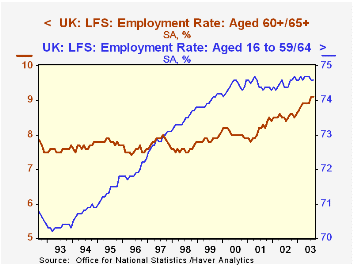 Global| Nov 12 2003
Global| Nov 12 2003Older Workers Increase Role in UK Job Market
Summary
Labor market conditions improved modestly in the three months ended September (data the UK Office of National Statistics reports as values for "August", that is, a centered 3-month average). Employment rose 28,000 from its total three [...]

Labor market conditions improved modestly in the three months ended September (data the UK Office of National Statistics reports as values for "August", that is, a centered 3-month average). Employment rose 28,000 from its total three months before (the comparison emphasized by the ONS in its data press release) and up 309,000 from a year ago. These totals have been revised upward somewhat this month to account for new population benchmarks. The unemployment rate held steady at 5.0%, showing very little movement over the last nine months. As we noted here in October, the number of claims for the "Jobseeker's Allowance", the so-called claimant count, is falling; it is now down for a fifth month, 3,300 in the latest month and 15,300 over the last year. Workers' earnings rose at a 3.6% pace in the July-September quarter, picking up from prior months' increases.
One facet of the employment gain in the "August" period highlights a developing trend. Older workers, men over 65 and women over 60, are increasing their participation in the job market. Their economic activity rates (comparable to participation rates in the US) are rising markedly, with that for men at 8.8% in the August period, up 0.8% from a year ago, and for women at 9.6%, up 0.4% from the 2002 period. By contrast, the economic activity rate for the population in the working age range, 16 to 64/59, is up only 0.1% on the year to 78.7%. In the latest 3-month period, "August" vs. "May", employment in the standard working age group fell 3,000, but employment of those older rose 32,000. Such absolute out-performance is not frequent, but proportionately, older workers are accounting for a substantial portion of job growth. In the last two 3-month periods, some 27% of the 12-month job gains have occurred in this population group, which covers only 3% of the economically active population and 22.5% of the total population over age 16.
| UK: Selected Labor Market Indicators | "Sep" (3 mos ended Oct) | "Aug" (3 mos ended Sep) | "Jul" (3 mos ended Aug) | Year Ago ("Aug") | 2002 | 2001 | 2000 |
|---|---|---|---|---|---|---|---|
| Unemployment Rate (%) | N.A. | 5.0 | 5.0 | 5.3 | 5.2 | 5.1 | 5.5 |
| Claimant Count (thous.) | 926.9* | 930.2* | 931.7* | 942.2* | 946.8 | 970.1 | 1,088.4 |
| Labor Force Employment (thous.) | N.A. | 28,151 | 28,109 | 27,842 | 27,846 | 27,658 | 27,425 |
| Average Earnings Index: "Headline Rate" (% Change) | N.A. | 3.6 | 3.4 | 3.7 | 3.5 | 4.6 | 4.6 |
Carol Stone, CBE
AuthorMore in Author Profile »Carol Stone, CBE came to Haver Analytics in 2003 following more than 35 years as a financial market economist at major Wall Street financial institutions, most especially Merrill Lynch and Nomura Securities. She had broad experience in analysis and forecasting of flow-of-funds accounts, the federal budget and Federal Reserve operations. At Nomura Securities, among other duties, she developed various indicator forecasting tools and edited a daily global publication produced in London and New York for readers in Tokyo. At Haver Analytics, Carol was a member of the Research Department, aiding database managers with research and documentation efforts, as well as posting commentary on select economic reports. In addition, she conducted Ways-of-the-World, a blog on economic issues for an Episcopal-Church-affiliated website, The Geranium Farm. During her career, Carol served as an officer of the Money Marketeers and the Downtown Economists Club. She had a PhD from NYU's Stern School of Business. She lived in Brooklyn, New York, and had a weekend home on Long Island.





